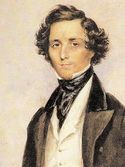
Felix Mendelssohn was born in Hamburg in 1809, into a cultured, educated and affluent family. During a life cut short at 38, he created a huge body of work ranging from concerto’s, chamber music and incidental music, through oratorios, lieder and symphonies. He was a child prodigy who played several instruments, began composing at a young age, and is considered by some to have been even more gifted than Mozart.
The Violin Concerto in Em, Opus 64, is one of Mendelssohn’s most well-known works and one of the greatest violin concertos ever composed. Written over several years, it was first performed in 1845 and by its dates belongs to the early Romantic period. This concerto, however, is more reminiscent of Mozart than Liszt or Chopin, with its relatively small orchestra, no trombones and no separate cello part.
The first movement begins with 1 1/2 bars of tremulous strings and sustained woodwinds, heightening the anticipation of the solo violin’s innovative early entrance with the first lyrical subject. The elegance and lightness of touch often associated with Mendelssohn is there, as well as a gracious relationship between soloist and orchestra, each getting their share of the attention. The transition to the second subject has it’s own theme, this time introduced by the orchestra and then followed by the soloist. The second subject sees another reversal of roles, initiated by a woodwind “choir” with the solo violin becoming accompanist.
Mendelssohn’s written-out cadenza is another innovation, placed before the recapitulation rather than, as was more common, at the end of the movement. The cadenza demands serious violinic skill but Mendelssohn abhorred ostentatious virtuosity, viewing it as vulgar and deleterious to the music. With the placement of the cadenza in the middle, the first movement is able to flow into the second through a single note held by the bassoon. Unlike Vivaldi, for example, who encouraged audience response between movements, Mendelssohn intended the three movements of the Violin Concerto in Em to be played through without pauses between movements, enabling the audience to hear the transitions from the E minor first movement, to the the C major second movement, and the E major final movement. The whole concerto can then be seen as a musical thought. Mendelssohn’s close association with Goethe is well known, and the way in which the final movement contains antecedents from the first comprises a sort of Goethean organic development.
Mendelssohn was hugely popular during his lifetime and also renowned for his prowess as a conductor. His audience tended to be based in the German Bürgertum, the educated and cultured urban who supported the arts and had initiated a shift from purely aristocratic patronage. Mendelssohn was also the driving force behind the creation of the Conservatorium of Music at Leipzig, which became the model on which music education is still based in Germany today.
Since then, however, the social and political context of Germany has had an ongoing impact on the popularity of his music. Sadly, despite his prodigious talent, Mendelssohn’s enduring success has been inextricably meshed with the question of his Jewish background. Wagner’s allusions to a Jewish conspiracy in music became damaging rhetoric in the hands of the Nazis. There was also a feeling, more prevalent in Germany than elsewhere, that Mendelssohn was a lightweight whose familial affluence had precluded him from experiencing the angst necessary to reach greatness. Surely the brilliance of his music should rise above all these other issues but even today, for Felix Mendelssohn, social context continues to draw an uneven interest.
The first movement begins with 1 1/2 bars of tremulous strings and sustained woodwinds, heightening the anticipation of the solo violin’s innovative early entrance with the first lyrical subject. The elegance and lightness of touch often associated with Mendelssohn is there, as well as a gracious relationship between soloist and orchestra, each getting their share of the attention. The transition to the second subject has it’s own theme, this time introduced by the orchestra and then followed by the soloist. The second subject sees another reversal of roles, initiated by a woodwind “choir” with the solo violin becoming accompanist.
Mendelssohn’s written-out cadenza is another innovation, placed before the recapitulation rather than, as was more common, at the end of the movement. The cadenza demands serious violinic skill but Mendelssohn abhorred ostentatious virtuosity, viewing it as vulgar and deleterious to the music. With the placement of the cadenza in the middle, the first movement is able to flow into the second through a single note held by the bassoon. Unlike Vivaldi, for example, who encouraged audience response between movements, Mendelssohn intended the three movements of the Violin Concerto in Em to be played through without pauses between movements, enabling the audience to hear the transitions from the E minor first movement, to the the C major second movement, and the E major final movement. The whole concerto can then be seen as a musical thought. Mendelssohn’s close association with Goethe is well known, and the way in which the final movement contains antecedents from the first comprises a sort of Goethean organic development.
Mendelssohn was hugely popular during his lifetime and also renowned for his prowess as a conductor. His audience tended to be based in the German Bürgertum, the educated and cultured urban who supported the arts and had initiated a shift from purely aristocratic patronage. Mendelssohn was also the driving force behind the creation of the Conservatorium of Music at Leipzig, which became the model on which music education is still based in Germany today.
Since then, however, the social and political context of Germany has had an ongoing impact on the popularity of his music. Sadly, despite his prodigious talent, Mendelssohn’s enduring success has been inextricably meshed with the question of his Jewish background. Wagner’s allusions to a Jewish conspiracy in music became damaging rhetoric in the hands of the Nazis. There was also a feeling, more prevalent in Germany than elsewhere, that Mendelssohn was a lightweight whose familial affluence had precluded him from experiencing the angst necessary to reach greatness. Surely the brilliance of his music should rise above all these other issues but even today, for Felix Mendelssohn, social context continues to draw an uneven interest.

 RSS Feed
RSS Feed